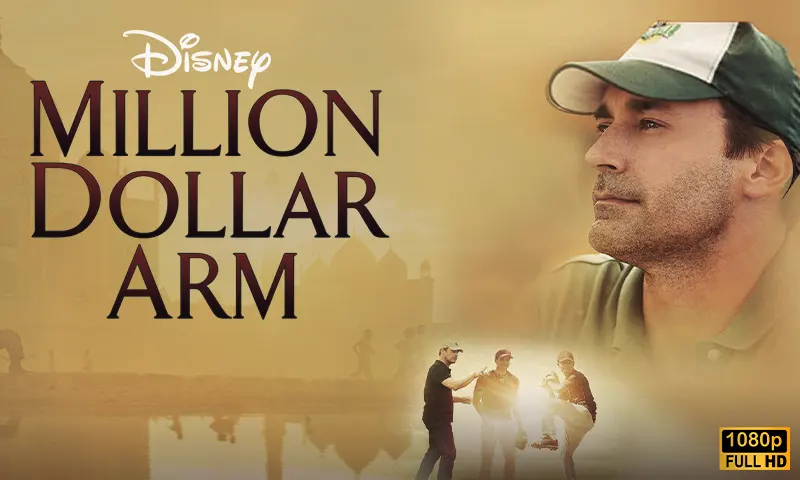
KEY TAKEAWAYS
- The movie’s theme brings Indian cricketers and baseball fans together to captivate the audience.
- Pitching ball with speed and technique convinces the lead character JB Bernstein, a sports agent, to search for exceptional talent in India.
- Actors John Hamm, Aasif Mandvi, and Alan Arkin with the director, Craig Gillespie create an inspiring sports saga with a hint of neocolonialism that makes it a good one-time watch.
“They never complain and they never quit.”
– Million Dollar Arm movie
Disney’s Million Dollar Arm is a movie based on the real-life story of a sports manager who goes to India to recruit cricketers to pitch in baseball. Though the two games might have certain mechanics that look similar (basically hitting a ball with a bat), they are very different.
But one common thing is the role of the ball. A pitcher pitches the ball in baseball and a bowler bowls it in cricket. Typically, the average speed of a pitch in professional baseball is roughly 150 Kmph. In professional cricket, bowlers throw the swing or seam style bowls at roughly 130 Kmph.
This is certainly comparable. The distance between the thrower (pitcher or bowler) and the hitter (batsman) is also surprisingly similar at roughly 60 ft.
However, in cricket, it’s common practice for the ball to make contact with the ground before being hit. In baseball, you pitch directly to the hitter’s bat or behind him. These, among other differences, are the challenges that the movie talks about.
Overall, the movie has a decent plot and good characters. Now that we’re fully familiar with the background of the movie, we can dive into the review.
Story
JB Bernstein is a sports agent with a declining career. One night, he gets a stroke of inspiration and before we know it, he’s in India to find a couple of pitchers for Major League Baseball. He organizes a talent hunt out of Indian cricketers and the story follows the improvements and character development they go through.
Though Bernstein usually scoffs at the game of cricket, not particularly liking it or anything, he ends up being inspired by some bowling action on the TV one night. His partner Aash and he are already in difficulty paying fresh talent owing to rising competition from other agents.
The duo understands that the games are mechanically different but Bernstein argues that both, fast bowling in cricket and fast pitching in baseball have speed in common. So, then, he asks, why couldn’t the next pitching stars be found from India?
JB goes out into the subcontinent to search for talent. He is aided by a financier and gets a deadline of one year. He partners with a talent scout to tour six Indian cities to finally come across two potential players—Rinku and Dinesh.
Everybody knows that Rinku and Dinesh are not going to become stars overnight or be a staple for MLB lines anytime soon, as they usually feature worldwide stars, such as Juan Soto, Roki Sasaki, Pete Alonso, and more. Yet, we know that they are going to excel ultimately. The movie tries in no way to hide all that and it’s quite predictable, though not necessarily in a bad way.
The team, now also accompanied by the cricketers’ translator, comes back to LA and is completely overwhelmed. As could be expected, the Indian boys struggle to fit into a new kind of world and that’s where JB’s love interest comes into play.
Brenda helps the boys feel at home. She also guides JB to be a better person toward them and not just their sports manager. Soon, the Indians adjust to the new climate and start becoming better in baseball.
Cricket is the king of sports in India, and owing to some of the similarities with baseball, the boys soon start to pick up a strategy or two.
MOVIE TRIVIA
Rinku Singh pitches left-handed but Suraj Sharma, who plays him, throws right-handed. They had to flip the image to make it appear as though he was pitching left-handed.
Plot Review
As expected, the movie sees India through the same old lens – overly crowded, extreme honking, spicy food, and the works. You get the idea. These are indeed stereotypes and cliches used as tropes to display the Indianness of Indian life in almost every Hollywood production featuring the country.
However, the execution differs from director to director.
In his movie, Craig Gillespie does a wonderful job of making it more heartwarming and the cliches a little less in-your-face than his peers. Add to that nice composition by A. R. Rahman and you have a package that has drama but in a nice way.
All that being said, the movie does have undertones of neocolonialism. It can be said that it is based on white people exploiting a developing nation’s resources, though it does a decent job of transforming all that into a more digestible narrative.
Mike McCahill of The Guardian writes, “Hamm and Alan Arkin’s grouchy scout conclude these deals with unarguable professionalism, but we can spot the maneuvers required to magic neocolonialist playbook into a heartwarming fairytale.”
The movie tries very hard to fit the description of the word “pleasant.” Almost too hard. As per Rotten Tomatoes critics, the score is 65%.
Final Verdict: 3.5/5
Overall, the movie is a nice package and has a little of everything. In many ways, it’s the best of both worlds—West and East—And tries to capture the fantasies of both types of cinema-goers. However, the execution and the storyline are not particularly deep or stimulating enough.
As such, our final score for this “sports” movie is 3.5/5. Let us know your thoughts in the comments!
